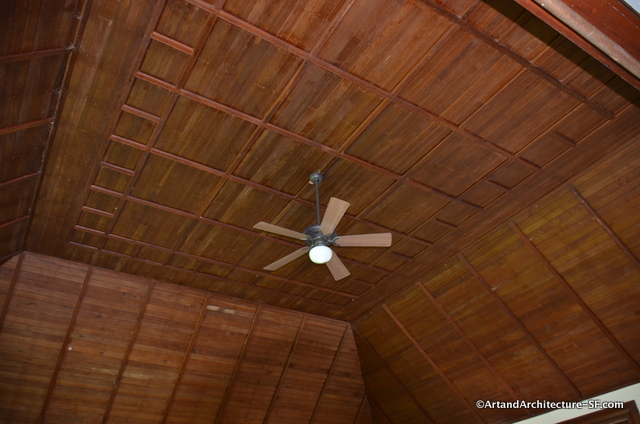Spring Green, Wisconsin

Built in 1957, the building was designed by Frank Lloyd Wright, who donated his design and 2 acres of land to the Wyoming School District in honor of his mother, Anna Lloyd-Jones Wright. It is the only public school ever designed by Wright.
The story goes that the school had land close to the road, but Wright, who truly believed in making architecture part of nature, wanted to build it into the small hill so he moved the building site back several 100 feet. It was not until later that it was discovered this was not property the school owned, Wright bought the two acres from the farmer who owned the land and gave it to the school.
Even with Wright’s generous donation the building did not have a budget large enough to be constructed, so many ways were found to help bring it in on budget, this included the use of cement block instead of stone, common light fixtures extended with standard plumbing pipe, and standard windows.

There are two fireplaces in the school. It is thought that only one was used, and this was often during Christmas pageants.
That same year, Wright was beginning construction on his redesigned Guggenheim Museum in New York, he was in the midst of a contentious battle regarding his 1955 design for the Monona Terrace Civic Center in Madison, and he was also in the midst of publicizing his
Mile High ‘Illinois’ Skyscraper. In addition to these he had also just completed the design for his Annunciation Greek Orthodox Church in Wauwatosa, Wisconsin and according to
Frank Lloyd Wright: The Complete Works, that same year his office produced designs for at least another 34 new building projects, of which at least nine would begin construction in 1956 or soon thereafter.
Considering how busy he was this was quite obviously a labor of love for Wright, an opportunity to show what schools should look like and a chance to honor his mother.

The clerestory lets in so much light, that the electric fixtures are often not needed to light the building
The school opened in 1958 with 46 students in grades 1 through 8. After consolidating with the River Valley School district the building was used by the district’s 4th graders until being closed in 1990.

There are 12 mitered windows throughout the building
It was sold then sold to a private owner for $305,000. The first owner lost it through bankruptcy and it was purchased again by Jeff Jacobsen, a local landowner and neighbor.
The building closed and sadly, remained empty for much of the next 20 years.
In August of 2010 the school was given to the not-for-profit Wyoming Valley School by Jeff Jacobsen.

Small details were added to make the cement block a tad more attractive

This is mirrored on the interior as well


A view of the back of the school, showing how it was built into the hill.
The school is open for tours by guides that are local and very knowledgable, they will regale you with not only stories about the schools architecture, but stories from the teachers and students who attended the school during its 30 year run.

Just down the street from the Wyoming Valley School and Taliesin East, is the Lloyd Jones Family Chapel.
The rumor is that Frank Lloyd Wright, at the age of 18, met architect Joseph Silsbee, the architect hired by Wright’s uncle, to build the chapel, and the Wright had a hand in the design. The story is probably apochryphal, but if he did have a hand in the design it most likely was the interior ceiling.

The church also houses the family graveyard. Wright was originally buried here, but was later dug up, cremated and his ashes were spread with his third wife in Arizona. There is still a grave stone honoring Wright.

Also, hidden away on the grounds is the grave of the love of Wright’s life, Mamah Borthwick Cheney.













[…] 1885, at the age of 18 Wright met architect Joseph Silsbee, who was building a chapel for Wright’s uncle in Helena Valley, Wisconsin. The following spring, Wright went to work for Silsbee’s firm in […]
[…] Presumably, to underscore his family’s connection to the church, Wright had the name of his uncle, who was a Unitarian minister, inscribed with the names of five other Unitarian and […]
[…] Presumably, to underscore his family’s connection to the church, Wright had the name of his uncle, who was a Unitarian minister, inscribed with the names of five other Unitarian and […]